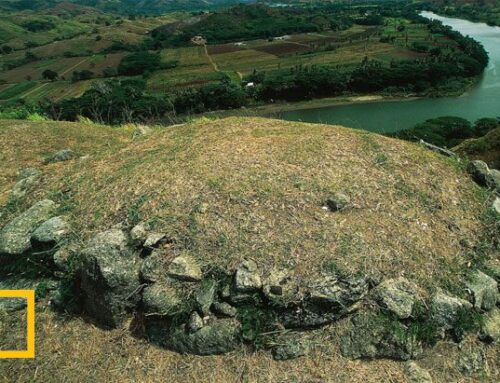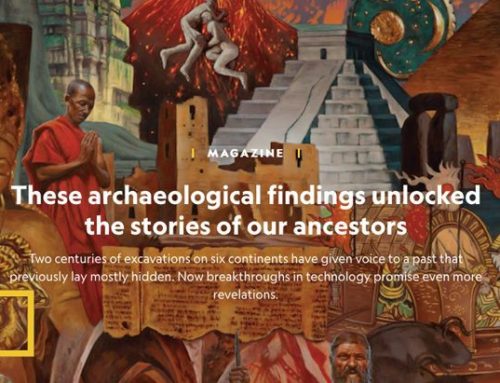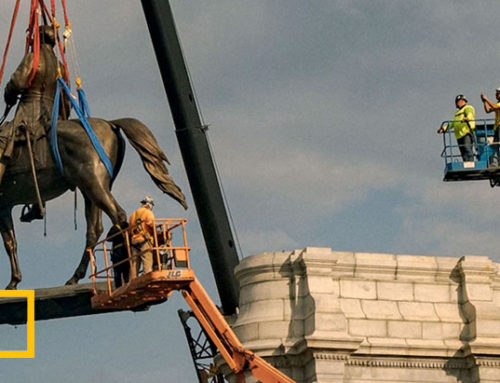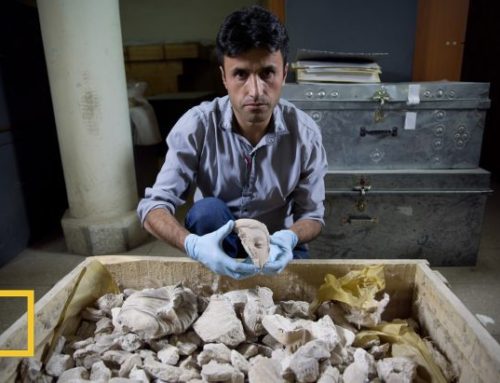Archaeologists hail the burial, untouched for 3,500 years, as the biggest discovery on mainland Greece in decades.

The text message from the trench supervisor to archaeologists Jack Davis and Sharon Stocker was succinct: “Better come. Hit bronze.”
The excavators exploring a small stone shaft on a rocky promontory in southern Greece had found an unusual tomb of an ancient warrior. The burial may hold important clues to the origin of Greek civilization some 3,500 years ago.
Along with the well-preserved skeleton of a man in his early thirties, the grave contains more than 1,400 objects arrayed on and around the body, including gold rings, silver cups, and an elaborate bronze sword with an ivory hilt.
More surprising were 50 stone seals intricately carved with goddesses, lions, and bulls, as well as a half-dozen delicate ivory combs, a bronze mirror, and some 1,000 carnelian, amethyst, and jasper beads once strung together as necklaces. Between the man’s legs lay an ivory plaque carved with a griffin.
“Not since Schliemann have complete burials of this type been found in Greece,” says John Bennet, an archaeologist at the University of Sheffield in Britain and director of the British School at Athens, who is not involved with the dig. In the late 19th century, archaeological pioneer Heinrich Schliemann excavated Troy and Mycenae, the major Greek center from about 1600 B.C. to 1100 B.C.
Light on a Dark Time
The grave is located at the southwest end of the Peloponnese peninsula at Pylos, a place mentioned by Homer in the Odyssey as the site of King Nestor’s palace with its “lofty halls.” Excavations before and after World War II revealed remnants of a large Mycenaean palace dating to about 1300 B.C., as well as hundreds of clay tablets written in the Linear B script developed on Crete, an island about 100 miles offshore. Those texts led to the translation of Linear B, and confirmed the identity of Pylos.
Not since Schliemann have complete burials of this type been found in Greece.
John Bennet
archaeologist at the University of Sheffield in Britain
and director of the British School at Athens
But little is known about the earlier period around 1500 B.C., when Mycenaean society was taking shape. Archaeologists have long debated the influence of Minoan civilization, which began to flourish in Crete around 2500 B.C., on the rise of Mycenaean society a thousand years later. Linear B tablets, bull horn symbols, and goddess figurines found at Mycenaean sites like Pylos attest to the impact of Minoan culture. Based on archaeological evidence of destruction, many scholars believe that the Mycenaeans invaded and conquered Crete around 1450 B.C.
In May, Davis and Stocker, a husband-and-wife team from the University of Cincinnati, assembled 35 experts from 10 nations to begin a five-year project aimed at uncovering Pylos’ beginnings. They hit pay dirt on the first day, when workers clearing a field spotted a rectangle of stones that proved to be the top of a four-foot by eight-foot shaft. Three feet down, the excavators spotted the first bronze artifacts. Based on their style, Davis and Stocker are confident that the remains date to about 1500 B.C.
Unexpected Objects Pose a Puzzle
“To find an unrobbed and rich Mycenaean tomb is very rare,” says Cynthia Shelmerdine, a classics professor at the University of Texas at Austin who visited the site during the summer’s excavations. “This one shows us some things we would not have anticipated.”
What’s peculiar about the tomb is that it contains only a single person and includes a remarkable wealth of mostly foreign objects, as well as artifacts typically associated with women.
To find an unrobbed and rich Mycenaean tomb is very rare.
Cynthia Shelmerdine
classics professor at the University of Texas at Austin
Resting places for the Mycenaean elite usually include many individuals. Just 100 yards from the new find, archaeologists excavated such a group tomb in the 1950s. Davis and Stocker estimate that three-quarters of the finished grave goods in the warrior’s shaft come from Crete—a two-day’s sail to the south—rather than from local sources. There are also amber beads from the Baltic, amethyst from the Middle East, and carnelian that may originate in Egypt that might have been brought to Crete by Minoan traders. “The range and number of Minoan or Minoan-style artifacts in this tomb should greatly deepen our knowledge about the extent of this relationship,” says Shelmerdine.
The presence of beads, combs, and a mirror in a warrior’s tomb poses a puzzle. “The discovery of so much precious jewelry with a male warrior-leader challenges the commonly-held belief that jewelry was buried only with wealthy females,” says Stocker. She adds that Spartan warriors ritually combed their hair before battle, while Davis suggests that the jewelry may have been offerings to the goddess from the dead man on his journey to the underworld.
The unusual nature of the Pylos tomb could mean that he was a Minoan warrior or leader, rather than a native Mycenaean. Alternatively, he may have fought in Crete and brought back plunder or developed a taste for Minoan goods. Or he may have been a Mycenaean leader who wanted to establish a new tradition. What’s clear, the archaeologists say, is that he didn’t want to be associated with the group tombs that were the norm for locals both before and after his death.
Skeletal analysis that may help the team pinpoint his identity will soon get under way, says Stocker. The well-preserved teeth could reveal his genetic background, while examination of the pelvis area may tell researchers about his diet. Studying the bones also may help determine the cause of death. Stocker and Davis will close up the tomb in coming weeks to concentrate on analyzing their many finds.




